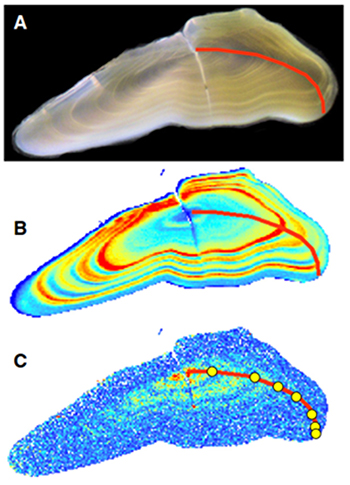X-RAY RUNS: Apply for Beamtime
2017 Nov 1 - Dec 21
2018 Feb 7 - Apr 3
2018 Proposal/BTR deadline: 12/1/17
2018 Apr 11 - Jun 4
2018 Proposal/BTR deadline: 2/1/18
Longtime CHESS user Karin E. Limburg has been bringing challenging problems in marine biology to CHESS for many years. One of her research specialties is using two-dimensional high-resolution elemental maps of small sections of fish ear stones, called otoliths, as time-stamped records of the histories of fishes’ lives and marine conditions. Her studies have challenged many CHESS scientists over the years to further develop scanning x-ray fluorescence microscopy (SXFM) at the F3 station, including Don Bilderback and Rong Huang who produced microbeams with tapered glass capillaries and Darren Dale who built software for rapid data collection, analysis and visualization of elemental maps (1,2).
Recently Limburg, from the State University of New York College of Environmental Science and Forestry in Syracuse NY, published with colleagues from Texas, California and Sweden a comprehensive study on the feasibility of using fish otoliths as biogeochemical markers – or mobile monitors - of low oxygen “hypoxic” or oxygen-free “anoxic” waterways (3). SXFM capabilities at CHESS provided the necessary high-resolution data to map the elemental composition of otoliths. Otoliths are small aragonitic structures formed by precipitation of calcium carbonate in a protein matrix. Because otoliths grow incrementally by a outer-shell-like deposition process, cross sections of otolith stones show “growth band” structures that provide a sequential history if studied by spatially-resolved SXFM. Over the past few years Limburg and collaborators have shown how non-destructive SXFM analysis of the “otolith chemistry” of these bands is a powerful forensic tool for uncovering the life histories of fishes and their environments.
In this paper the authors set out to demonstrate that manganese found in otoliths is associated with biogeochemically favorable redox conditions and can therefore be used as a tracer of encountering hypoxic waters. They establish that uptake of manganese is thus distinct from uptake of other environmental elements such as strontium, barium, iodine and sulfur which all correlate well with external conditions such as salinity and temperature. They show data contrasting otolith manganese update in fishes collected in different waters, and document a wide variety of fish species ranging across families and from freshwater to marine environments. Sensitivity to multiple elements and with suitable spatial resolution were achieved using SXFM at the F3 station using a beam spot focused from 100 down to 20 microns, as needed. Two-dimensional maps of each element were produced by rapid raster scans across sectioned otoliths (figure 1). Their study corroborated data from other analysis tools, including laser ablation inductively coupled plasma mass spectrometry (LA-ICPMS) and secondary ion mass spectrometry (SIMS).

Figure 1. Otolith of a Baltic cod, age 7, in visible light (A) and strontium SXFM mapping (B). The strontium trace varies as the fish migrates, whereas manganese (C) declines with age.
The authors conclude that although knowing all the ways that fish interact with hypoxic zones is hard to determine, a variety of trace elements (Mn, Fe, I, and Zn) incorporated into otoliths can be used to reliably determine extrinsic conditions such as hypoxia, suboxia, or anoxia. They show how quantitative measures of manganese, and ratios with calcium, can be used as a reliable means to quantify hypoxia exposure and establish how biogeochemical tracers, primarily manganese, are useful to uncover the lifetime exposures to hypoxia by individual fish. In this time when worldwide climate stress and nutrient loads from land to water are increasing, establishing reliable techniques to discover, record and track low oxygen or oxygen-free aquatic environments is growing in importance.
References:
[1] Karin E. Limburg, Rong Huang, and Donald H. Bilderback, "Fish otolith trace element maps: new approaches with synchrotron microbeam x-ray fluorescence," X-Ray Spectrometry 36 (5), 336-342 (2007).
[2] Karin E. Limburg, Carina Olson, Yvonne Walther, Darren Dale, Caroline P. Slomp, and Hans Høie, "Tracking Baltic hypoxia and cod migration over millennia with natural tags," Proceedings of the National Academy of Sciences 108 (22), E177–E182 (2011).
[3] Karin E. Limburg, Benjamin D. Walther, Zunli Lu, George Jackman, John Mohan, Yvonne Walther, Anders Nissling, Peter K. Weber, and Axel K. Schmitt, "In search of the dead zone: Use of otoliths for tracking fish exposure to hypoxia," Journal of Marine Systems 141 (0), 167-178 (2015).
Submitted by: Ernest Fontes, CHESS, Cornell University
03/10/2015
